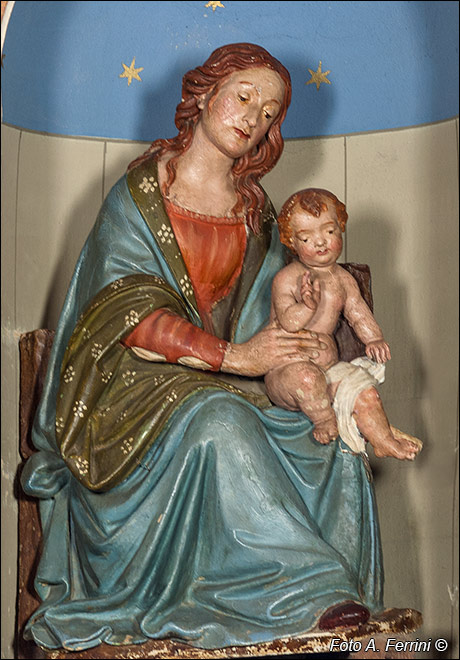Dal piccolo borgo di Capraia a Santa Trinita
Il sentiero da Capraia a Badia Santa Trinita e possibile ritorno su due percorsi diversi
Italiano
LUOGHI E PERCORSI NEI PRESSI DI BADIA SANTA TRINITA 16
Nella cappella della Chiesa di Capraia è conservata questa pregevole Madonna con Bambino in terracotta policroma. L'opera, databile ultimi anni del XV secolo, apparteneva in origine a Badia Santa Trinita. Difficile dire quando sia stata spostata a Capraia, si suppone nel XVII secolo quando l'abbazia si trovava già in un avanzato stato di degrado. A proposito di questo trasferimento vi sono un fatto tragico e una leggenda che illustriamo alle pagine 83 e 88 di questa sequenza. L'autore di questa terracotta è ignoto, un paio di storici dell'arte, da un'analisi molto veloce dell'opera, si sono trovati concordi nel supporre che potrebbe trattarsi di un lavoro di Leonardo del Tasso, scultore e intagliatore fiorentino che nella sua breve vita (1465-1500) lavorò spesso per i benedettini, compresi i vallombrosani. Quest'ultimi dal 1425 erano divenuti proprietari dell'Abbazia, questo rafforzerebbe l'ipotesi.
This valuable Madonna and Child in polychrome terracotta is preserved in the chapel of the Church of Capraia. The work, dating back to the last years of the 15th century, originally belonged to Badia Santa Trinita. It is difficult to say when it was moved to Capraia, it is assumed in the 17th century when the abbey was already in an advanced state of decay. Regarding this transfer there is a tragic fact and a legend which we illustrate on pages 83 and 88 of this sequence. The author of this terracotta is unknown, a couple of art historians, from a very quick analysis of the work, found themselves in agreement in supposing that it could be a work by Leonardo del Tasso, a Florentine sculptor and carver who in In his short life (1465-1500) he often worked for the Benedictines, including the Vallombrosans. The latter had become owners of the Abbey since 1425, this would strengthen the hypothesis.











































































































